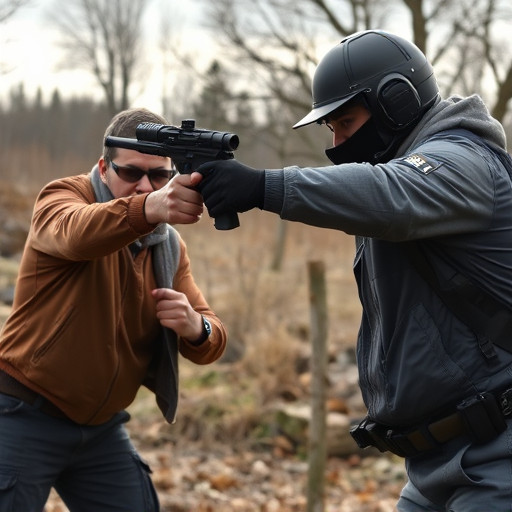High-Powered Stun Guns: Unlocking Amperage for Safety and Legality
High-powered stun guns, with voltages up to 40,000 volts and amperages measured in joules, temporari…….
High-powered stun guns, with voltages up to 40,000 volts and amperages measured in joules, temporarily disable targets by disrupting nerve signals. Their effectiveness and safety depend on voltage, current, pulse width, electrode design, and proper training. "High-powered stun guns for sale" must adhere to strict regulations regarding distribution, purchase, and carrying, with laws dictating maximum amperage or voltage output. Users should match amperage to intended use, balancing power and control, while adhering to safe handling practices including training, understanding range and activation mechanisms, appropriate targeting, inspections, storage, and adherence to guidelines.
Electrical shock weapons, specifically high-powered stun guns, have emerged as controversial yet potent tools for self-defense. This comprehensive article delves into the intricacies of these devices, focusing on amperage—a critical factor in their effectiveness. We explore the science behind stun guns, dissecting the ‘unlocking amperage mystery’ to provide insights for those considering high-powered stun guns for sale. Additionally, we cover legal aspects and safety precautions, guiding you in making informed choices tailored to your needs.
- Understanding Electrical Shock Weapons: A Comprehensive Overview
- High-Powered Stun Guns: Unlocking the Amperage Mystery
- Legal Considerations and Safety Precautions
- Choosing the Right Stun Gun for Your Needs
Understanding Electrical Shock Weapons: A Comprehensive Overview

Electrical shock weapons, also known as stun guns, are devices designed to temporarily incapacitate individuals through the application of electric current. These tools have gained popularity for personal protection, with various high-powered stun guns for sale in the market catering to differing needs and levels of threat perception. Understanding how they work is crucial when considering their use. Stun guns operate by delivering a strong electrical pulse that disrupts the body’s nerve signals, leading to muscle spasms and temporary paralysis.
The effectiveness of these weapons relies on specific parameters like voltage, current, and pulse width. High-voltage stun guns, for instance, can generate significant amperage, typically ranging from 10,000 to 40,000 volts, ensuring a powerful shock that can subdue an attacker momentarily. However, it’s essential to note that proper use and training are vital to guarantee safety and minimize the risk of severe or permanent injury.
High-Powered Stun Guns: Unlocking the Amperage Mystery

High-powered stun guns, also known as electric shock weapons, have gained popularity among personal defense enthusiasts and law enforcement agencies alike. When considering a purchase, understanding the amperage—a measure of electrical current—is crucial. These devices deliver a powerful jolt, typically in the range of 10,000 to 20,000 volts AC (or higher), with the goal of temporarily incapacitating a target through muscle contraction and pain compliance. The amperage plays a significant role in determining the intensity and effectiveness of the shock, making it a key factor when choosing a high-powered stun gun for sale.
While many manufacturers offer varying amperage ratings, it’s essential to remember that voltage alone doesn’t guarantee performance. The design, shape, and quality of the electrodes also contribute to the weapon’s ability to deliver a strong, consistent shock. As such, when shopping for these devices, buyers should look beyond just amperage specifications and consider other factors that ensure safety and reliability in critical situations.
Legal Considerations and Safety Precautions

The use and possession of high-powered stun guns for sale are governed by strict legal frameworks due to their potential impact on public safety. Many countries and regions have implemented regulations to control the distribution, purchase, and carrying of such devices. These laws often require users to possess a license or permit, setting clear boundaries for legitimate use. Additionally, there are specific rules regarding the amperage or voltage output allowed in stun weapons to ensure they do not cause severe harm or death.
Safety precautions are paramount when handling or employing high-amperage stun guns. Users must undergo proper training and adhere to guidelines to minimize risks. This includes understanding the weapon’s range, activation mechanisms, and appropriate targeting techniques. Furthermore, it is crucial to maintain regular inspections and upkeep of the device to guarantee its reliable operation. Safety measures should also extend to storage, ensuring the gun is kept in a secure location to prevent unauthorized access, especially for devices with high voltage capabilities that could pose significant hazards if misused.
Choosing the Right Stun Gun for Your Needs

When considering a stun gun, it’s crucial to match its amperage with your intended use. High-powered stun guns for sale typically offer higher joule ratings, which determine the force of the electric shock. For personal safety at home or in situations where you need to subdue an attacker without causing serious harm, lower amperage (20,000-40,000 joules) models are suitable.
For more extreme scenarios, like self-defense against larger threats or law enforcement training, opt for stun guns with higher amperages (upwards of 50,000 joules). Keep in mind that higher amperage doesn’t always mean better; it’s about finding the right balance between power and control to meet your specific needs.
In conclusion, high-powered stun guns, with their ability to deliver controlled electrical shocks, offer a powerful tool for personal safety. Understanding amperage and the legal landscape is key when considering these devices. With the right knowledge, individuals can make informed choices when purchasing high-powered stun guns for sale, ensuring they are equipped with an effective self-defense mechanism while adhering to relevant regulations.


